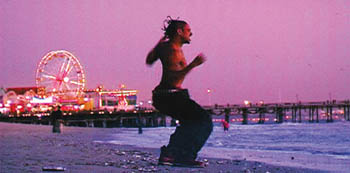![[Metroactive Movies]](/movies/gifs/movies468.gif)
[ Movies Index | Show Times | Silicon Valley | Metroactive Home | Archives ]

Photograph by David LaChapelle Meet the Krumper: Little C, an L.A. krumper, works out on the beach in David LaChapelle dance documentary. Fighting Clowns In 'Rize,' South-Central L.A. clowners and krumpers speed up the dance floor THE LEGACY of culture ripped off from African Americans must embitter black people's hearts. Still, David LaChapelle's documentary Rize is a joyous, satisfying account of the newest dance moves from Los Angeles. LaChapelle is a sometime portrait photographer who has made music videos for Jennifer Lopez, Avril Lavigne and Elton John. In the late 1990s, LaChapelle began filming post-hip-hop dancers: highly athletic, frenzied, shaking all over. They perform almost Pentecostal movements, like the ecstasies that gave the Quakers and the Shakers their names. (A disclaimer stresses that nothing we see has been digitally speeded up.) "Clowning" was derived from the choreography of one Thomas "Tommy the Clown" Johnson, an L.A. birthday clown who started up some young associates. According to Rize, there are about 50 clown crews in L.A. today. Clowns are always a little scary. An intimidated 3-year-old guest of honor at a birthday party watches Tommy and his crew and doesn't know what to make of them. LaChapelle has a clue, though. He places the rise of clowning against the hopelessness following the Rodney King riots. With their whitened faces and multicolored raiment, clowns never have to choose red or blue—to pledge allegiance either to the Crips or the Bloods. Soon there was a drastic spin-off of clowning—"krumping." Krumping is tougher and more chesty. Dancers come on up and get in each other's faces, as if ready to square off. Sometimes, the moves are accompanied with stripperish ass rotation and the ripping off of sweat-soaked shirts. Children do it, too. "I see we got little 4-year-olds popping their booties," considers one interviewee. Clowners and krumpers meet annually for sold-out dance contests at the Forum sports stadium in Inglewood, and Rize takes in the best of these new-style dancers in concert. Good news from South-Central is hard to come by. But LaChapelle is careful to record the backgrounds of dancers such as the wiry champion Ms. Prissy, Dragon, Tight Eyez and his protégé, Baby Tight Eyez. Ms. Prissy sums up South-Central: "Some people don't feel comfortable out of here—it's scary to go to Hollywood when you're from the hood." Rize records the death of Quinesha Dunford, a 15-year-old victim of the endemic drive-by shootings. There's a spot of mirthless humor when LaChapelle interviews the avuncular owner of Payless Caskets. He warns, "Old people are supposed to die first, but I see you young people are getting us beat. ... You better clown right, or you'll end up here." I can't exaggerate the strength and beauty of these dancers. Even the "big boy" division exalt themselves onstage. Rize is a far smarter and more realistic look at L.A. tensions than the dismayingly overpraised Crash. Still, when LaChapelle shows documentary footage of traditional tribal African dance, he might be going back a little far. More recent examples could be Mardi Gras crews, like the battlefront dances the Wild Tchoupitoulas sing about. Tommy the Clown mentions carnival dancing, even if we don't see it onscreen. "I know about battle dances back in the day. I just brought it back."
Rize (PG-13; 84 min.), a documentary by Dave LaChapelle, opens Friday at selected theaters.
Send a letter to the editor about this story to letters@metronews.com. [ Silicon Valley | Metroactive Home | Archives ]
|
From the June 22-28, 2005 issue of Metro, Silicon Valley's Weekly Newspaper.
Copyright © 2005 Metro Publishing Inc. Metroactive is affiliated with the Boulevards Network.
For more information about the San Jose/Silicon Valley area, visit sanjose.com.